Western Australia (WA) is an ancient, energetic land, brimming with opportunity ready for you to discover. Wherever the journey takes you, we look forward to welcoming you to WA!
The largest in area of Australia's states and territories, WA is also home to the largest proportion of people born overseas. With over 2.5 million people from more than 190 countries calling it home, WA has a rich cultural diversity.
WA offers locals and newcomers a strong economy, low unemployment, global and new emerging industries, excellent healthcare, infrastructure, education and exquisite natural landscapes inspiring year-round exploration.
It’s no secret that WA is an amazing place to live, study, work and raise a family!
WA's capital city of Perth is a safe, clean and vibrant city that's consistently ranked in the world's top 10 most liveable cities, and in 2023 WA was named by Lonely Planet as one of the top five global journeys.
Discover WA
WA is home to some of the most beautiful and unique landscapes in the world. From Broome’s red ochre rock and the turquoise waters of the Coral Coast in the north, to the bustling bars, restaurants and shopping precincts in Perth, down to the vineyards, beaches and wineries of the South, WA really does have something for everyone.
As one of the world’s most important mining regions, WA’s lifestyle, population and economic prosperity sustain stable expansion, guaranteeing that we are competitively placed for future investment and growth.
WA is also particularly well-positioned as a gateway to the Asia-Pacific region; making study, working or investing, and traveling in WA accessible like no other.
No matter what kind of lifestyle you’re after; you’ll find it here — there’s so much to discover in WA, starting with the capital city of Perth.
Pictured: Enjoying an evening aerial view of Perth, on the Matagarup Bridge zipline(opens in a new tab).
Nestled within the vast landscape of WA where the winding Swan River joins the southwest coast, Perth is Australia’s sunniest capital city blending vibrant urban cool with laid back natural beauty. Bustling with restaurants, bars, cultural spaces and shopping, Perth is also home to Kings Park, one of the world’s largest and most beautiful inner-city parks.
You can explore the idyllic vineyards and serene landscapes of the Swan Valley, just a 30-minute drive from the Perth city centre. Or follow the coast to discover 19 scenic beaches strung along the 50km metropolitan shoreline – WAs lifestyle is like no other.
Perth is regularly recognised in the world’s best destinations by Lonely Planet, National Geographic, the New York Times and Forbes.
The Swan River Colony (later renamed Perth) was established by the British Government in 1829. Traditionally known as Boorloo, Perth sits on the historic land of the Whadjuk Noongar people, one of 14 Noongar clans that make up the largest Aboriginal cultural block in Australia. The Noongar people have been the Traditional Custodians of the south west of WA for at least 45,000 years.
You can find out more about Aboriginal culture in Western Australia by visiting the WA Indigenous Tourism Operators Council website(opens in a new tab), or through a simple internet search for “Western Australian Aboriginal culture”. Visit the Western Australia website(opens in a new tab) to explore a range of available Aboriginal experiences that will take you on a journey through the Dreamtime and across the State.
Say hello in Noongar: Kaya.
Australia has a diverse range of climate zones, varying from tropical in the north to temperate in the south. Being the largest state, WA enjoys both of these climate zones.
Perth has more days of sunshine than any other major Australian city, with the south west corner of WA enjoying a Mediterranean climate and the north of the state typically being warmer.
You can visit the Bureau of Meteorology website(opens in a new tab) for seasonal weather statistics and forecasts across Australia.
Perth’s central business district (CBD) is situated on the beautiful Swan River and made up of offices, financial institutions, and several dining and retail attractions. Adjacent to the CBD sits Perth’s vibrant Northbridge entertainment district offering cafés, restaurants, bars, nightlife, cultural events and festivals. For those wanting an urban lifestyle, key inner city suburbs where apartment living is prominent include:
- Perth (city);
- East Perth;
- West Perth;
- South Perth; and
- Northbridge.
Neighbouring suburbs that are close to the Perth city area, with both apartments and character homes plus popular café strips, recreation facilities and parks include:
- Leederville;
- Subiaco;
- Mount Hawthorn; and
- Mount Lawley.
Northern suburbs
Also referred to by locals as ‘north of the river’, the northern suburbs line the coast and expand inwards. House prices generally increase the closer you are to the coast. The northern suburbs are generally well established; however, newly established suburbs continue to pop up and are regularly releasing new estates with vacant land.
Southern suburbs
Also known as ‘south of the river’, the southern suburbs are generally well established and include newer estates with vacant land. Fremantle (20 km from Perth CBD) offers a mix of contemporary housing, heritage cottages and apartment living. Fremantle is home to WA’s busiest working port and is also known for its music, arts and culture, festivals, retail stores, markets, cafés, and restaurants.
Eastern suburbs
Perth's eastern suburbs represents an attractive destination for visitors and provides a high-quality of life for residents. The region is home to a number of core assets including an extensive range of heritage, culture and arts attractions including Guildford, which is one of the oldest settled areas in Western Australia, and the popular Swan Valley which is becoming a popular area with semi-rural property, residential housing and regular land releases available.
For a less suburban lifestyle, ‘the hills’ on the eastern fringe of Perth offer spectacular scenery, native bushland and generally larger properties. Driving through Darling Scarp townships such as Armadale, Mundaring and Kalamunda you'll find breath taking views, heritage-listed hotels and country charm a plenty.
With nature trails, art galleries, farmers markets, fruit picking and wine tasting, the hills make a perfect lifestyle destination just 45 minutes from the Perth CBD.
Education is at the heart of WA, with more than 125 high-quality education providers including schools, colleges, pathway providers, English language institutions and five universities that are ranked in the top 40 worldwide in many subjects. With such a selection of quality education providers, and a bustling local and international student cohort, you’ll find lots of support and flexible study pathways.
Visit our Education and training page to find out more about WA's education system.
To find out about training, you can explore courses by industry area on the Jobs and Skills WA website(opens in a new tab), or if you are located in WA you can call your local Jobs and Skills Centre on 13 64 64 for free training advice.
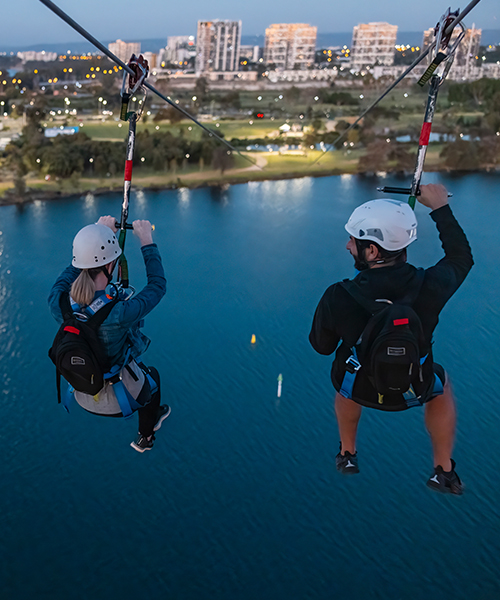
Explore our regions
From white sandy beaches and spectacular outback gorges in the north, to lush vineyards and forests in the south west to the golden landscapes of the east, there is a vast variety of environments and lifestyles offered across WA's nine regions.
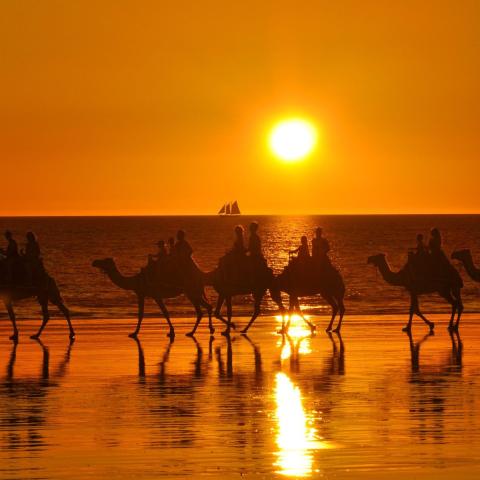
Broome, in WA's Kimberley region, is famous for its 22 km stretch of white sand along Cable Beach where you can enjoy a camel ride at sunset.
Pictured: Summer Day; Camels walking on a sunset lit beach, Sunset camel ride at Cable Beach, Broome.
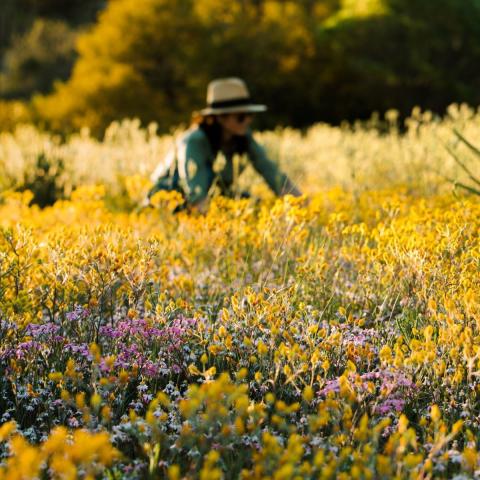
Wildflowers are abundant across all of WA's regions, with colourful displays to enjoy throughout the year even in the orange sands of the Goldfields and Wheatbelt.
Pictured: Sarah Hewer; Migrant woman surrounded by yellow and pink wildflowers, near Eaglestone Rock.
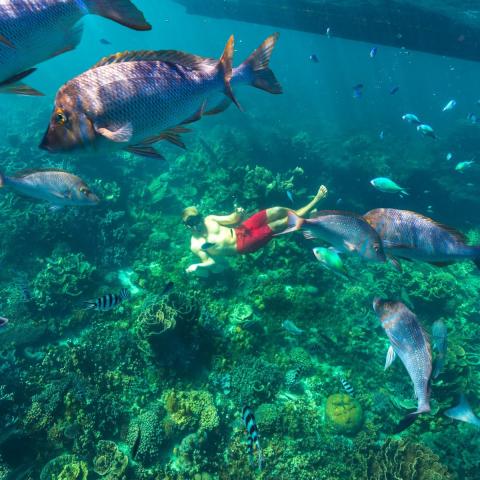
The clear, clean and warm waters of WA's northern coast are the perfect place to dive in and explore our marine environments and ocean life.
Pictured: Dan Avila; Man snorkeling amongst large fish and coral in Coral Bay.

The South West of WA offers beautiful natural landscapes, including ancient forests of tall trees to explore from the ground or a treetop walk.
Pictured: Dan Avila; large green trees at the Valley of the Giants, Tree Top Walk.
Living in a regional area of WA is popular due to the peaceful and relaxed lifestyle it offers. Match this with a range of quality services, infrastructure, shopping and entertainment options and add pristine beaches, world class wineries, a rich cultural history and spectacular national parks all within driving distance for a quick day trip or to explore on a weekend away — regional WA has something for everyone!
Information about the unique features of each of WA's nine regions, and the employment opportunities they offer, is outlined below.
The Gascoyne is a great place for you and your family to settle in. With an average of 320 days of sunshine a year, this is a popular destination for those of you seeking a warm climate all year round! Located in the northwest of WA with more than 600 km of Indian Ocean coastline, the Gascoyne extends inland to desert landscapes and the Aboriginal community of Burringurrah.
With lots of natural environment to encourage you outdoors, this region lends itself superbly to boating, fishing, camping, surfing and sport; and its economy is based on tourism, fishing, retail, mining, horticulture and pastoralism, and small business. One of the main tourist attractions in the Gascoyne is Ningaloo Reef, a coral reef stretching over 260 km and considered one of Earth’s last ocean paradises. The surrounding area includes the Kennedy Range and Mount Augustus.
If you choose to live in one of its three major coastal towns – Carnarvon, Exmouth and Shark Bay – you’ll never be far from a beach. With median house prices significantly lower than Perth, its clean environment and supportive local community make it a welcoming region in which to settle. Carnarvon, Exmouth and Shark Bay offer primary school education while secondary school facilities are located in Exmouth and Carnarvon. There are also some private schools in Carnarvon. The Central Regional TAFE campuses in Carnarvon and Exmouth offer qualifications in a wide range of Certificates, Diplomas and Advanced Diplomas.
Training options and career guidance
Central Regional TAFE(opens in a new tab) offers a wide range of courses throughout the Gascoyne region. Campuses are located in Carnarvon(opens in a new tab) and Exmouth(opens in a new tab). For career guidance and information on training courses, visit the Jobs and Skills WA website(opens in a new tab) or call a Jobs and Skills Centre on 13 64 64.
Useful links
Gascoyne Development Commission(opens in a new tab)
Regional Development Australia – Mid West Gascoyne(opens in a new tab)
Situated in the south eastern corner of Western Australia, this is the largest region in the State. Well known for its great sense of community spirit and its friendly inhabitants, this region has a long, rich association with gold and nickel mining, along with agriculture producing wheat and barley. This is the place for you if you want to be close to nature, love the outdoors and want to immerse yourself in unspoilt landscapes and seascapes. You can also experience a vibrant arts scene, great shopping, bars, restaurants and cafes and enjoy sporting activities. Come and experience this great lifestyle for yourself!
The region offers you a range of employment and business opportunities, including tourism, agriculture, health and mining as well as many trades. Retail is the second largest employer followed by manufacturing. Commercial fishing operates mainly along the coastlines of the shires of Ravensthorpe and Esperance. It has a reputation for innovation, uniqueness and diversity, with Curtin University delivering vibrant higher education in the dynamic and sophisticated regional centre, Kalgoorlie–Boulder. A simple internet search for median house price in the region will present you with details about property data.
Goldfields-Esperance migration pathways
Skilled Employer Sponsored Regional (Provisional) visa (subclass 494)
The Skilled Employer Sponsored Regional (Provisional) visa (subclass 494) (SESR) is a Department of Home Affairs visa that allows Australian employers in regional Australia to sponsor (nominate) skilled migrants to fill employment vacancies, where the employer cannot source an appropriately skilled Australian worker.
Employers in regional Australia can nominate skilled migrants to fill a full time vacancy, ongoing for at least two years, where there is a demonstrated and genuine need for a paid employee. Regional Development Australia(opens in a new tab) is the Regional Certifying Body (RCB) for the Goldfields–Esperance region. Contact them directly to find out more about the assessment process.
T: +61 8 9091 6051 (from outside Australia)
E: admin@rdage.com.au
Designated Area Migration Agreement
The City of Kalgoorlie—Boulder has established a Designated Area Migration Agreement (DAMA) with the Department of Home Affairs. This agreement has its own occupation list providing employers in the region with access to a broader range of skilled workers, utilising the labour agreement stream of the Skills in Demand (formerly TSS) visa (subclass 482)(opens in a new tab), the Skilled Employer Sponsored Regional (Provisional) visa (subclass 494)(opens in a new tab) and the Employer Nomination Scheme (subclass 186)(opens in a new tab). The WA Government is not formally involved in the City of Kalgoorlie—Boulder DAMA. Employers in this region should contact the City of Kalgoorlie—Boulder(opens in a new tab) for further information.
T: +61 8 9021 9600 (from outside Australia)
E: mailbag@ckb.wa.gov.au
Training options and career guidance
The Western Australian School of Mines(opens in a new tab) located in Kalgoorlie offers various science courses. Central Regional TAFE(opens in a new tab) in Kalgoorlie and South Regional TAFE(opens in a new tab) in Esperance offer a range of courses at their campuses. For career guidance and information on training courses, visit the Jobs and Skills WA website(opens in a new tab) or call a Jobs and Skills Centre on 13 64 64.
Useful links
Goldfields—Esperance Development Commission(opens in a new tab)
Regional Development Australia Goldfields—Esperance(opens in a new tab)
You’ll find the people in this region friendly and welcoming — it’s no wonder that it’s the destination of choice for many skilled migrants in the professional, trades and services sectors. The stunning scenery is a great attraction in itself, especially for those of you who appreciate nature. With a rich variety of flora and fauna in the rugged Porongurup and Stirling Ranges, the natural sweeping views and the serene beauty of the seascape and landscape are impressive. The historic port city of Albany offers rugged coastlines, tall timber forests and clean, safe environment while other towns such as Denmark, Esperance and Mount Barker are equally idyllic. With heaps of outdoor activities to enjoy, a thriving arts and entertainment scene and affordable housing, the Great Southern region offers you the chance to live the dream!
The Great Southern region is WA’s second largest agricultural producer with the focus on grains and livestock. Its economy is driven by primary production – wool, timber, livestock and fishing — with key growth areas in the transport, engineering and commercial services areas. Viticulture and tourism also play a large role, attracting a growing number of tourists every year.
Training options and career guidance
South Regional TAFE(opens in a new tab) is the region's largest provider of nationally accredited training, industry and lifestyle courses. Campuses are located in:
- Albany(opens in a new tab);
- Denmark(opens in a new tab);
- Katanning(opens in a new tab); and
- Mount Barker(opens in a new tab).
The University of Western Australia's(opens in a new tab) Albany Centre offers a number of undergraduate courses.
For career guidance and information on training courses, visit the Jobs and Skills WA website(opens in a new tab) or call a Jobs and Skills Centre on 13 64 64.
Useful links
Great Southern Development Commission(opens in a new tab)
Regional Development Australia – Great Southern(opens in a new tab)
An ancient landscape covering hundreds of thousands of square kilometres, with unique and dramatic landscapes and stunning outback settings that are like no other, the Kimberley region comprises outback desert, impressive deep, rocky gorges, limestone caves, sandstone cliffs, grassy plateaus, thundering waterfalls, and an abundance of wildlife. It is also home to the magnificent Lake Argyle, the largest freshwater lake in mainland Australia.
Three times larger than England but with a population of less than 40,000 people; you'll enjoy stunning beaches, native wildlife, natural gorges and canyons, freshwater swimming holes with no shortage of land to explore and unique cultural experiences.
Mining, construction, tourism and hospitality, retail, agriculture, and pearling are major contributors to the region's economy and offer fantastic employment opportunities.
Kimberley migration pathways
Designated Area Migration Agreement
The East Kimberley Chamber of Commerce and Industry has established a Designated Area Migration Agreement (DAMA) with the Department of Home Affairs. This agreement has its own occupation list providing employers in the Shire of Wyndham with access to a broader range of skilled workers, utilising the labour agreement stream of the Skills in Demand (formerly TSS) visa (subclass 482)(opens in a new tab), the Skilled Employer Sponsored Regional (Provisional) visa (subclass 494)(opens in a new tab) and the Employer Nomination Scheme (subclass 186)(opens in a new tab). The WA Government is not formally involved in the East Kimberley DAMA. Employers in this region should contact the East Kimberley Chamber of Commerce and Industry(opens in a new tab) for further information.
T: +61 429 484 662 (from outside Australia)
E: dama@ekcci.com.au
Training options and career guidance
North Regional TAFE(opens in a new tab) offers over 160 qualifications and short courses throughout the region. Campuses are located in:
- Broome(opens in a new tab);
- Derby(opens in a new tab);
- Fitzroy Crossing(opens in a new tab);
- Halls Creek(opens in a new tab);
- Kununurra(opens in a new tab); and
- Wyndham(opens in a new tab).
Notre Dame University's(opens in a new tab) Broome campus offers vocational education and training, tertiary pathway programs, higher degree and research opportunities.
For career guidance and information on training courses, visit the Jobs and Skills WA website(opens in a new tab) or call a Jobs and Skills Centre on 13 64 64.
Useful links
Kimberley Development Commission(opens in a new tab)
Regional Development Australia – Kimberley(opens in a new tab)
The Mid West region is widely recognised for its unique natural environment, comprising a coastline dominated by limestone cliffs and is the perfect playground if you like to indulge in water sports. The city of Geraldton on the magnificent Batavia coast is home to around 70% of this region’s population, but if you head east for 800 km, you’ll enter a mineral rich hinterland that borders the Pilbara and Goldfields–Esperance regions. Add a Mediterranean climate with hot, dry summers and cold, dry winters and you find a great location for starting off your new life in WA. Strong, supportive social infrastructure and relatively cheap housing add to this region’s attractions.
The Mid West has a diverse economy built around tourism, fishing, agriculture and mining. There is also a fairly significant manufacturing sector catering to the needs of the mining, fishing and agricultural industries both within and outside the region.
Training options and career guidance
Central Regional TAFE(opens in a new tab) is one of the main training providers in the Mid West region. Campuses are located in:
- Geraldton(opens in a new tab) (main campus); and
- Batavia Coast(opens in a new tab);
For career guidance and information on training courses, visit the Jobs and Skills WA website(opens in a new tab) or call a Jobs and Skills Centre on 13 64 64.
Useful links
Mid West Development Commission(opens in a new tab)
Regional Development Australia – Mid West Gascoyne(opens in a new tab)
The Peel region is the fastest growing of all the regions in WA with well-serviced infrastructure and attractive lifestyle options contributing to its popularity. With a growing number of residential developments, it is a popular choice for skilled migrants wanting the variety of a coastal and rural lifestyle – and all within easy reach of the Perth metropolitan area! With over 43 government and private schools and numerous well-equipped sporting facilities and venues, it is an ideal location that’s big on lifestyle yet less than an hour (75 km) from Perth by car or train.
The city of Mandurah is the regional business hub and home to around 65% of the region’s population. Offering cosmopolitan city living with historic riches and a coastal lifestyle, and known for its spectacular waterways and the Peel–Harvey estuary’s abundant wildlife, pristine beaches and natural beauty, it’s the ideal place to create your future!
The retail sector is a large employer and an important contributor to the Peel economy. Other major employers are construction and manufacturing along with a large number of employees working in healthcare and social assistance, and food and accommodation services. Its largest industry is alumina production, along with mining and mineral processing.
Training options and career guidance
The Peel Education and Training campus located in Mandurah hosts courses delivered by:
- South Metropolitan TAFE Peel (Mandurah)(opens in a new tab);
- Murdoch University(opens in a new tab); and
- John Tonkin College(opens in a new tab).
For career guidance and information on training courses, visit the Jobs and Skills WA website(opens in a new tab) or call a Jobs and Skills Centre on 13 64 64.
Useful links
The centre of Australia’s mining and oil and gas industries and rich in natural resources – predominantly iron ore – the Pilbara region is the mining powerhouse of WA and critical to Australia’s economy. It is full of contrasts and surprises with spectacular gorges, ravines, waterfalls and vast red deserts. With the Indian Ocean to the northwest and the Great Sandy Desert in the east, the diverse landscape within the Pilbara region offers a variety of lifestyles.
The major Pilbara towns of Karratha and Port Hedland have grown significantly in the past 10 years, with considerable investment in new shopping centres, hospitals, schools, and sports and recreational facilities – transforming the towns into modern hubs for the region. Two major airports connect the region to Perth and other Australian cities.
Pilbara migration pathways
Designated Area Migration Agreement
Regional Development Australia Pilbara (RDA Pilbara) has established a Designated Area Migration Agreement (DAMA) with the Department of Home Affairs. This agreement has its own occupation list providing employers in the Shire of East Pilbara, City of Karratha, and the Town of Port Hedland with access to a broader range of skilled workers, utilising the labour agreement stream of the Skills in Demand (formerly TSS) visa (subclass 482)(opens in a new tab), the Skilled Employer Sponsored Regional (Provisional) visa (subclass 494)(opens in a new tab) and the Employer Nomination Scheme (subclass 186).(opens in a new tab) The WA Government is not formally involved in the Pilbara DAMA. Employers in this region should contact RDA Pilbara(opens in a new tab) for further information.
T: 0499 325 584
E: dama@rdapilbara.org.au
Training options and career guidance
North Regional TAFE(opens in a new tab) is one of the main training providers in the region offering a range of courses at campuses located in:
- Karratha(opens in a new tab);
- Newman(opens in a new tab);
- Tom Price(opens in a new tab);
- Minurmarghali Mia (Roebourne)(opens in a new tab); and
- Pundulmurra (Hedland)(opens in a new tab).
For career guidance and information on training courses, visit the Jobs and Skills WA website(opens in a new tab) or call a Jobs and Skills Centre on 13 64 64.
Useful links
Pilbara Development Commission(opens in a new tab)
Regional Development Australia – Pilbara(opens in a new tab)
With a great sense of community and connectedness and an enviable lifestyle, residents of South West WA rate their region as a safe, family-friendly place to live. It features some of the State’s best beaches, forests, wine regions and national parks, and the climate in this dynamic, evolving region in the picturesque south western corner of WA is ideal for migrants due to its spectacular nature and diverse employment opportunities.
Lifestyle and thriving employment opportunities available in the region make the South West a popular choice to live and invest in. The main industry sectors and employers include mining and minerals (coal, alumina, mineral sands), manufacturing (timber products; food and beverage enterprises), building and construction (residential housing developments), tourism (wine regions; surfing; forests), food and agribusiness (primary produce; food and vegetables), wine and viticulture, forestry, fishing and aquaculture, retail and commerce, health, and smart and creative industries such as boutique artisans; film-makers; and visual arts. The city of Bunbury is the commercial and administrative hub of this region.
South West migration pathways
Designated Area Migration Agreement
The South West region has established a Designated Area Migration Agreement (DAMA) with the Department of Home Affairs. This agreement has its own occupation list providing employers in the South West region with access to a broader range of skilled workers, utilising the labour agreement stream of the Skills in Demand (formerly TSS) visa (subclass 482)(opens in a new tab), the Skilled Employer Sponsored Regional (Provisional) visa (subclass 494)(opens in a new tab) and the Employer Nomination Scheme (subclass 186).(opens in a new tab) The WA Government is not formally involved in the South West DAMA. Employers in this region should contact the Shire of Dardanup(opens in a new tab) for further information.
T: +61 8 9724 0000 (from outside Australia)
E: dama@dardanup.wa.gov.au
Training options and career guidance
South Regional TAFE(opens in a new tab) has numerous courses available with campuses located in:
- Bunbury(opens in a new tab);
- Busselton(opens in a new tab);
- Collie(opens in a new tab);
- Harvey(opens in a new tab);
- Manjimup(opens in a new tab); and
- Margaret River(opens in a new tab) (part of the Margaret River Education campus).
Edith Cowan University's South West Campus(opens in a new tab) located in Bunbury is the university's largest campus outside of the metropolitan area.
Margaret River Education campus hosts range of courses delivered by:
- South Regional TAFE(opens in a new tab);
- Curtin University(opens in a new tab); and
- Edith Cowan University(opens in a new tab).
For career guidance and information on training courses, visit the Jobs and Skills WA website(opens in a new tab) or call a Jobs and Skills Centre on 13 64 64.
Useful links
South West Development Commission(opens in a new tab)
Regional Development Australia – South West(opens in a new tab)
The Wheatbelt region belongs to a vast and surprisingly diverse region of outback Australia known as Western Australia’s Golden Outback. Also known as the Heartlands, the Wheatbelt offers you an escape from city life in a safe and relaxed environment with more than 200 towns and communities offering a range of liveability options. Some of the attractions in the region include the Narembeen Grain Discovery Centre(opens in a new tab), Wave Rock near Hyden, and the Wagin Historical Village(opens in a new tab). The Shire of Northam is the largest regional centre, with population distributed throughout the region which boasts 150 km of a pristine coastline lucrative to the fishing industry — particularly rock lobsters for domestic consumption and export.
The Wheatbelt is well known for its magnificent wildflowers as well as for its rich agricultural history in cropping – producing almost half of WA's agricultural crops. It is the main producer of cereal crops and other products such as canola, vegetables, honey, citrus fruits, olives, wine grapes and livestock. Its vibrant economy is supported by construction, the retail trade and fisheries. It also offers affordable housing and extensive education, health, cultural and recreational services.
Training options and career guidance
Central Regional TAFE(opens in a new tab) and South Regional TAFE(opens in a new tab) deliver a range of training and education services in the Wheatbelt region. Campuses are located in:
- Merredin(opens in a new tab);
- Narrogin(opens in a new tab);
- Northam(opens in a new tab); and
- Moora(opens in a new tab).
Muresk Institute(opens in a new tab) (located in Northam) hosts the delivery of various agriculture and agribusiness courses.
For career guidance and information on training courses, visit the Jobs and Skills WA website(opens in a new tab) or call a Jobs and Skills Centre on 13 64 64.
Useful links
Wheatbelt Development Commission(opens in a new tab)
Regional Development Australia – Wheatbelt(opens in a new tab)
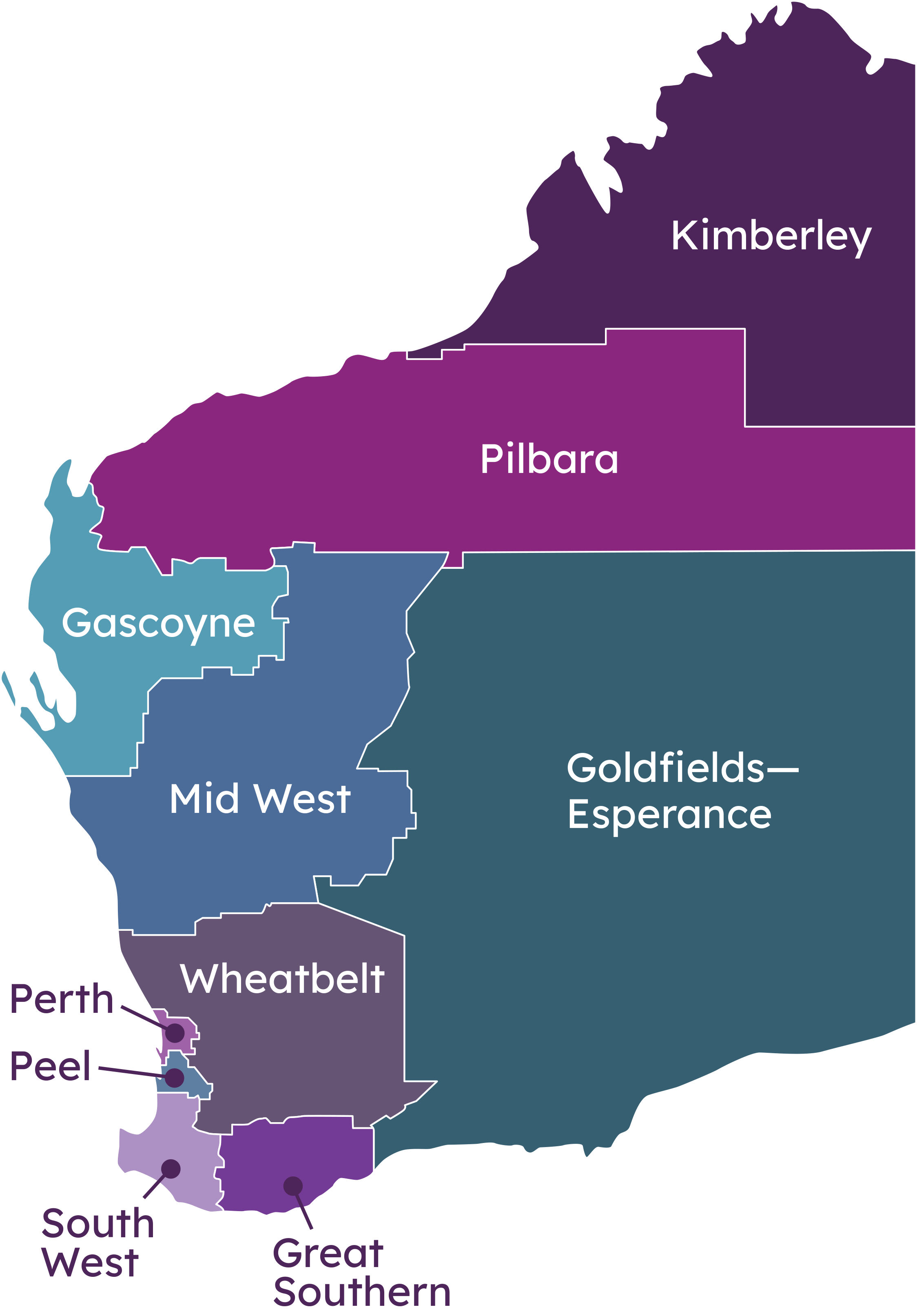
For more information on regional WA, visit the Tourism Western Australia website(opens in a new tab).